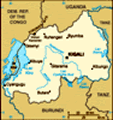Rwandan Economy, Rwanda Economy
Advertisement
Economy - overview: Rwanda is a poor rural country with about 90% of the population engaged in (mainly subsistence) agriculture. It is the most densely populated country in Africa; landlocked with few natural resources and minimal industry. Primary foreign exchange earners are coffee and tea. The 1994 genocide decimated Rwanda's fragile economic base, severely impoverished the population, particularly women, and eroded the country's ability to attract private and external investment. However, Rwanda has made substantial progress in stabilizing and rehabilitating its economy to pre-1994 levels, although poverty levels are higher now. GDP has rebounded and inflation has been curbed. Export earnings, however, have been hindered by low beverage prices, depriving the country of much needed hard currency. Despite Rwanda's fertile ecosystem, food production often does not keep pace with population growth, requiring food imports. Rwanda continues to receive substantial aid money and was approved for IMF-World Bank Heavily Indebted Poor Country (HIPC) initiative debt relief in late 2000. Kigali's high defense expenditures have caused tension between the government and international donors and lending agencies. An energy shortage and instability in neighboring states may slow growth in 2005, while the lack of adequate transportation linkages to other countries continues to handicap export growth.
GDP: 3.2% (2004)
GDP - real growth rate: 0.9% (2004 est.)
GDP - per capita: Purchasing power parity - $1,300 (2004 est.)
GDP - composition by sector: Agriculture: 41.1% industry: 21.2% services: 37.7% (2004 est.)
Population below poverty line: 60% (2001 est.)
Household income or consumption by percentage share: Lowest 10%: 4.2% highest 10%: 24.2% (1985)
Distribution of family income - Gini index: 28.9 (1985)
Inflation rate (consumer prices):
Labor force: 4.6 million (2000)
Labor force - by occupation: Agriculture 90%
Unemployment rate: NA
Budget: Revenues: $354.5 million expenditures: $385 million, including capital expenditures of NA (2004 est.)
Industries: Cement, agricultural products, small-scale beverages, soap, furniture, shoes, plastic goods, textiles, cigarettes
Industrial production growth rate: 7% (2001 est.)
Electricity - production: 166.7 million kWh (2002)
Electricity - production by source:
Electricity - consumption: 195 million kWh (2002)
Electricity - exports: 0 kWh (2002)
Electricity - imports: 40 million kWh (2002)
Oil - production: 0 bbl/day (2001 est.)
Oil - consumption: 5,300 bbl/day (2001 est.)
Oil - exports: NA
Oil - imports: NA
Oil - proved reserves: 0 bbl (1 January 2002)
Natural gas - production:
Natural gas - consumption:
Natural gas - exports:
Natural gas - imports:
Natural gas - proved reserves: 28.32 billion cu m (1 January 2002)
Agriculture - products: Coffee, tea, pyrethrum (insecticide made from chrysanthemums), bananas, beans, sorghum, potatoes; livestock
Exports: $69.78 million f.o.b. (2004 est.)
Exports - commodities: Coffee, tea, hides, tin ore
Exports - partners: Indonesia 64.2%, China 3.6%, Germany 2.7% (2004)
Imports: $260 million f.o.b. (2004 est.)
Imports - commodities: Foodstuffs, machinery and equipment, steel, petroleum products, cement and construction material
Imports - partners: Kenya 24.4%, Germany 7.4%, Belgium 6.6%, Uganda 6.3%, France 5.1% (2004)
Debt - external: $1.3 billion (2000 est.)
Economic aid - recipient: $372.9 million (1999)
Currency:
Currency code:
Exchange rates: Rwandan francs per US dollar - 574.62 (2004), 537.66 (2003), 476.33 (2002), 442.8 (2001), 393.44 (2000)
Fiscal year: Calendar year
Advertisement
The information here has been derived from Public Domain Sources such as the CIA World Factbook. No liability can be taken for any inaccuracies.
Tot: 0.071s; Tpl: 0.008s; cc: 3; qc: 10; dbt: 0.0409s; 1; m:domysql w:travelblog (10.17.0.13); sld: 1;
; mem: 1.1mb

 In 1959, three years before independence from Belgium, the majority ethnic group, the Hutus, overthrew the ruling Tutsi king. Over the next several years, thousands of Tutsis were killed, and some 150,000 driven into exile in neighboring countries. T...
In 1959, three years before independence from Belgium, the majority ethnic group, the Hutus, overthrew the ruling Tutsi king. Over the next several years, thousands of Tutsis were killed, and some 150,000 driven into exile in neighboring countries. T...
